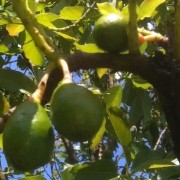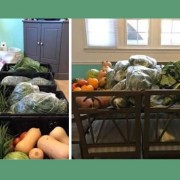Out of tragedy, a vegan dream is born
Yummvees vegan meals & treats come to Seasonal Roots
– By the Veggie Fairy Team and Tracy, owner of Yummvees
You don’t have to be vegan to appreciate totally plant-based food — when done right, it’s so awesomely delicious that the nutritious, eco-friendly part is like icing on the cinnamon bun! That’s why we fairies are all aflutter about teaming up with a local family business that knows how to do it right.
Yummvees in Midlothian, Va., cooks up freshly made vegan meals, desserts, and snacks. The meals are ready-to-heat, which makes it super convenient — you don’t have to sacrifice nutrition on those days when you’re just too busy and tired to cook.
But first we want to introduce you to Tracy, the woman behind Yummvees. Her story is inspiring, and as you get to know her, you’re going to feel as good about being nourished by her as we do.
VEGGIE FAIRY:
How did Yummvees get started?
TRACY:
In 2015, a life changing event happened to my family.
My son, John, passed away at birth. Shortly after this I had a true life wake up call. I felt like I had to act on that dream that had always been in the back of my head (we all have them) but I’d never pursued — the dream of making the world a better place through plant-based food. I have always loved cooking for others and, of course, my respect for animals and all living beings is immense. I HAD to act on that dream… to honor my son. So in 2016, Yummvees was officially born as a 100% vegan/plant-based food service/catering facility.
VEGGIE FAIRY:
Starting a business you believe in — has it turned out to be everything you hoped it would be?
TRACY:
Every minute has been wonderful!
We provide weekly individual meal options, baked goods, granola, various sweets, family sized meals, and bulk side items. Our individual meal menus change week to week, so as to keep folks engaged, trying new things, and excited for the next week. Every day, I have the distinct honor (and it really is that), to share wonderful, healthy, and indulgent foods with people, all in honor of my child who is not here with us.
VEGGIE FAIRY:
Are most of your customers vegan?
TRACY:
Oh no, just the opposite.
Most of our customer base is not vegan, which I particularly love, because we are exposing them to foods that they may not have otherwise tried… and it’s allowing them to add more veggies/beans/legumes and different protein sources to their diet. We use very minimal processed ingredients and almost everything that we produce is handmade — if it isn’t yet, we are probably working on experimenting with it.
VEGGIE FAIRY:
You also donate a portion of sales, right?
TRACY:
That’s right. Every month, we donate a portion of our total sales
to a chosen organization/family and tend to focus on bereaved parents, animal related organizations… or just someone that we see, who needs a little bit of help. On our website homepage, we list who we are donating to (unless it’s an individual, we do that privately) so that others can see who they are supporting by purchasing from us. We also allow our supporters to make individual contributions, plus we share links to other giving opportunities. THIS is how we honor our child. And we are so lucky to have an amazing community of people, small business owners who support each other, and new customers every day who allow us to make at least a tiny bit of a difference.
VEGGIE FAIRY:
As a family business, who does what?
TRACY:
I do most of the cooking, but we truly are a family operation.
My older daughter Selena is our primary delivery person. When I do the deliveries, people chuckle as I walk to their door juggling Joni, my 9-month-old daughter, and their food order. Yeah, there’s quite a gap between Selena and Joni — I get many chuckles there, too!
VEGGIE FAIRY:
What are your hopes for the future?
TRACY:
Looking ahead, we are excited about our expansion!
And our ability to give back more, working within our community to make it a better one, and to keep showing folks how plant-based foods are amazing. We are so thrilled and excited to work with Seasonal Roots by offering folks more options for plant-based/vegan foods and I am ecstatic to be cooking for a whole new crowd of folks! Happy eating!
ABOUT SEASONAL ROOTS
Since 2011, Seasonal Roots’ online farmers market has connected Virginia families with local family farmers who use sustainable, humane practices. Our veggie fairies – mostly moms who believe in living better through scrumptious, healthy eating, being kind to animals, protecting the environment, and spreading joy – home-deliver freshly harvested produce, eggs, grass-fed dairy and meat, plus artisan fare. We empower our members to eat better and live better with more nutritious, flavorful food that’s good for us and good for the planet. More info at seasonalroots.com.
















